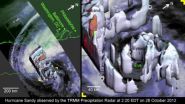(Press-News.org) Biologists from the University of Bonn have discovered that the cichlid fish Pelvicachromis taeniatus can see in the near infrared range; this was thought to be unlikely until now. Seeing in the infrared range is apparently helping fish to hunt in shallow African rivers. The results will be published in the journal "Naturwissenschaften" and are already available online now.
A research team in the work group of Prof. Dr. T. C. M. Bakker at the Institute for Evolutionary Biology and Ecology, University of Bonn, has been studying the biology of the African cichlid fish Pelvicachromis taeniatus for years.
Researchers conducted a prey choice experiment
Researchers investigated the ability to see in the infrared range using a classical prey choice experiment. P. taeniatus also feeds on small crustaceans, such as freshwater shrimp. These prey animals reflect near infrared radiation. The researchers used this fact to examine the perception of infrared light. In a dark room a prey selection experiment was set up illuminated by infrared lamps. In front of the water basin containing the fish freshwater shrimp were offered in two separate chambers. One of the chambers with the prey was covered with a filter blocking infrared wavelengths. The other chamber was covered with a filter that would let only infrared light pass. "Consequently, the fish were only able to perceive the freshwater shrimp in one chamber in the near infrared range" explains Dr. |Sebastian Baldauf, one of the scientists involved in the study.
Physiologists thought that seeing in the near ir range would be unlikely
The experiment showed that the fish spent more time and were more frequently in front of the chamber that let infrared light pass. "The fish detect their prey based on infrared radiation alone" reports the biologist from the University of Bonn. "Until now, physiologists thought that noise levels in the near-infrared range were too high to allow visual perception." As the experiment has shown, the fish were capable of perceiving prey in a wavelength range above 780 nanometers. It is well-known that snakes can perceive far infrared radiation at longer wavelengths above 2,000 nanometers. "But they don't use their eyes for this purpose; instead they have a heat-sensitive pit organ," says Dr. Baldauf. Human eyes are not capable of seeing infrared radiation.
Seeing infrared is useful in the natural habitat
The advantage of the fish's ability to see infrared may become obvious when you look at its natural habitat. The shallow rivers of West Africa have a relatively large amount of infrared radiation. "That's exactly why it makes sense to use infrared cues for detecting prey organisms," explains Dr. Baldauf. "It is a clear selective advantage if you can perceive additional signals that others cannot perceive." It is quite likely that other animals also have evolved a perception of near-infrared radiation, e.g. for hunting or orientation, such as other fishes or birds. The researchers from the University of Bonn now want to study more closely the physiology of infrared vision, and to what extent infrared radiation is relevant in other contexts.
Infrared radiation in partner selection?
When performing color measurements on these fish the researchers found that certain regions of the cichlid body reflect the light in the near-infared range. "We found that females reflect infrared radiation from their belly region, and males from their fins" says Dr. Baldauf. The female belly is important for mate choice, and the fins are displayed during aggressive encounters between males. "Perhaps near-infrared signals play a role in visual communication in this species" says the biologist. "And that's what we additionally would like to study in further experiments."
###
Publication: Denis Meuthen, Ingolf P. Rick, Timo Thünken, Sebastian A. Baldauf: Visual prey detection by near-infrared cues in a fish, "Naturwissenschaften", DOI: 10.1007/s00114-012-0980-7
Contact:
Dr. Sebastian A. Baldauf
Institut für Evolutionsbiologie und Ökologie
Ph. +49 228/735749
Email: sbaldauf@evolution.uni-bonn.de END
Infrared vision in a cichlid fish
Scientists at the University of Bonn discovered that fish can detect prey using infrared light
2012-10-30
ELSE PRESS RELEASES FROM THIS DATE:
Researchers to debate the call for sexual abstinence education in schools
2012-10-30
Introducing abstinence education into UK schools could be a less effective substitute for comprehensive Sex and Relationship Education (SRE) aimed at children and young adults, say a research team led by Sheffield Hallam University.
As part of the Economic and Social Research Council (ESRC) Festival of Social Science 2012, Sheffield Hallam and partners will host a one day event to debate the issues surrounding abstinence education.
Dr Julia Hirst, from the Public Health Hub at Sheffield Hallam, says "We hope to bring together politicians, teachers, youth workers, young ...
Reducing radiation: Heart Institute model shows hope for new standards worldwide
2012-10-30
Toronto, October 29, 2012 – The University of Ottawa Heart Institute (UOHI) is setting the stage in what could become a revolution in medical imaging in Canada as it announces striking results in radiation reduction for the diagnosis of cardiovascular disease. The announcement comes as UOHI is currently showcasing its expertise at the 2012 Canadian Cardiovascular Congress in Toronto.
As a result of an initiative that combines optimizing test protocols, state-of-the art equipment, and high-tech software, two-thirds of the Ottawa Heart Institute's Nuclear Cardiology patients ...
Cocktail achieves superconducting boost
2012-10-30
Physicists describe how they have synthesized a new material that belongs to the iron-selenide class of superconductors, called LixFe2Se2(NH3)y, in a paper about to be published in EPJ B. The work was carried out by Ernst-Wilhelm Scheidt from the University of Augsburg and colleagues. This material displays promising superconducting transition temperatures of 44 Kelvins (K) at ambient pressure, thus improving upon traditional copper-based high-temperature superconductors.
The ultimate goal of scientists developing such materials is to reach superconducting characteristics ...
Curiosity on Mars sits on rocks similar to those found in marshes in Mexico
2012-10-30
Millions of years ago fire and water forged the gypsum rocks locked in at Cuatro Ciénegas, a Mexican valley similar to the Martian crater where NASA's Rover Curiosity roams. A team of researchers have now analysed the bacterial communities that have survived in these inhospitable springs since the beginning of life on Earth.
"Cuatro Ciénegas is extraordinarily similar to Mars. As well as the Gale crater where Curiosity is currently located on its exploration of the red planet, this landscape is the home to gypsum formed by fire beneath the seabed," as explained to SINC ...
Enigmatic nematics
2012-10-30
Physicists use hydrodynamics to understand the physical mechanism responsible for changes in the long-range order of groups of particles. Particularly, Aparna Baskaran of Brandeis University, Massachusetts, USA, and Cristina Marchetti of Syracuse University, New York, USA, focused on ordered groups of elongated self-propelled particles. They studied the breakdown of long-range order due to fluctuations that render them unstable and give rise to complex structures, in a study about to be published in EPJ E.
The authors coined the term self-propelled nematics to refer ...
New developments reveal a molecule with a promising function in terms of cancer treatment.
2012-10-30
Researchers from Inserm and CNRS from the Institute for genetics and molecular and cellular biology (IGBMC) and from the Research Institute at the Strasbourg school of biotechnology (Irebs) have focussed their efforts on PARG, currently thought to be a promising new therapeutic target in the treatment of cancer. Their work has revealed the role of this molecule in regulating gene expression. The results were published on 25 October 2012 in the on-line Molecular Cell review.
Cells are subjected to various stresses throughout their life. Some of this stress can damage DNA. ...
ORNL debuts Titan supercomputer
2012-10-30
OAK RIDGE, Tenn., Oct. 29, 2012 — The U.S. Department of Energy's (DOE) Oak Ridge National Laboratory launched a new era of scientific supercomputing today with Titan, a system capable of churning through more than 20,000 trillion calculations each second—or 20 petaflops—by employing a family of processors called graphic processing units first created for computer gaming. Titan will be 10 times more powerful than ORNL's last world-leading system, Jaguar, while overcoming power and space limitations inherent in the previous generation of high-performance computers.
Titan, ...
NASA's TRMM satellite analyzes Hurricane Sandy in 3-D
2012-10-30
NASA's Tropical Rainfall Measuring Mission, or TRMM satellite can measure rainfall rates and cloud heights in tropical cyclones, and was used to create an image to look into Hurricane Sandy on Oct. 28, 2012. Owen Kelly of NASA's Goddard Space Flight Center in Greenbelt, Md. created this image of Hurricane Sandy using TRMM data.
At 2:20 p.m. EDT on Sunday, Oct. 28, Hurricane Sandy was a marginal category 1 hurricane and its eyewall is modest, as TRMM reveals, which gives forecasters and scientists hints about its possible future strength.
The eyewall appeared somewhat ...
Prostate cancer prognosis hope
2012-10-30
Scientists have discovered a molecular 'tell' in laboratory experiments that could help doctors determine the severity of a patient's prostate cancer.
Cancer of the prostate – the most common male cancer in the UK – presents in two distinct ways: a low-risk type, which may never cause any symptoms, and a high-risk form that needs treatment to prevent it spreading to other parts of the body.
Knowing which type of prostate cancer each patient has – some 40,000 British men per year – is therefore essential to ensuring they receive the correct treatment.
Lead researcher ...
Radiation treatment after surgery improves survival for elderly women with early-stage breast cancer
2012-10-30
BOSTON, Mass. – Oct. 29, 2012. Elderly women with early-stage breast cancer live longer with radiation therapy and surgery compared with surgery alone, researchers at the University of Maryland School of Medicine have found. The researchers, who collected data on almost 30,000 women, ages 70 to 84, with early, highly treatable breast cancer enrolled in a nationwide cancer registry, are reporting their findings at the 54th annual meeting of the American Society for Radiation Oncology (ASTRO).
"Overall survival and breast cancer-specific survival were significantly better ...
LAST 30 PRESS RELEASES:
Structure of dopamine-releasing neurons relates to the type of circuits they form for smell-processing
Reducing social isolation protects the brain in later life
Keeping the heart healthy increases longevity even after cancer
Young adults commonly mix cannabis with nicotine and tobacco
Comprehensive review illuminates tau protein's dual nature in brain health, disease, and emerging psychiatric connections
Book prepares K-12 leaders for the next public health crisis
Storms in the Southern Ocean mitigates global warming
Seals on the move: Research reveals key data for offshore development and international ecology
Sports injuries sustained during your period might be more severe
World's first successful 2 Tbit/s free-space optical communication using small optical terminals mountable on satellites and HAPS
Can intimate relationships affect your heart? New study says ‘yes’
Scalable and healable gradient textiles for multi‑scenario radiative cooling via bicomponent blow spinning
Research shows informed traders never let a good climate crisis go to waste
Intelligent XGBoost framework enhances asphalt pavement skid resistance assessment
Dual-function biomaterials for postoperative osteosarcoma: Tumor suppression and bone regeneration
New framework reveals where transport emissions concentrate in Singapore
NTP-enhanced lattice oxygen activation in Ce-Co catalysts for low-temperature soot combustion
Synergistic interface engineering in Cu-Zn-Ce catalysts for efficient CO2 hydrogenation to methanol
COVID-19 leaves a lasting mark on the human brain
Scientists use ultrasound to soften and treat cancer tumors without damaging healthy tissue
Community swimming program for Black youth boosts skills, sense of belonging, study finds
Specific depressive symptoms in midlife linked to increased dementia risk
An ‘illuminating’ design sheds light on cholesterol
Who is more likely to get long COVID?
Study showcases resilience and rapid growth of “living rocks”
Naval Research Lab diver earns Office of Naval Research 2025 Sailor of the Year
New Mayo-led study establishes practical definition for rapidly progressive dementia
Fossil fuel industry’s “climate false solutions” reinforce its power and aggravate environmental injustice
Researchers reveal bias in a widely used measure of algorithm performance
Alcohol causes cancer. A study from IOCB Prague confirms damage to DNA and shows how cells defend against it
[Press-News.org] Infrared vision in a cichlid fishScientists at the University of Bonn discovered that fish can detect prey using infrared light


